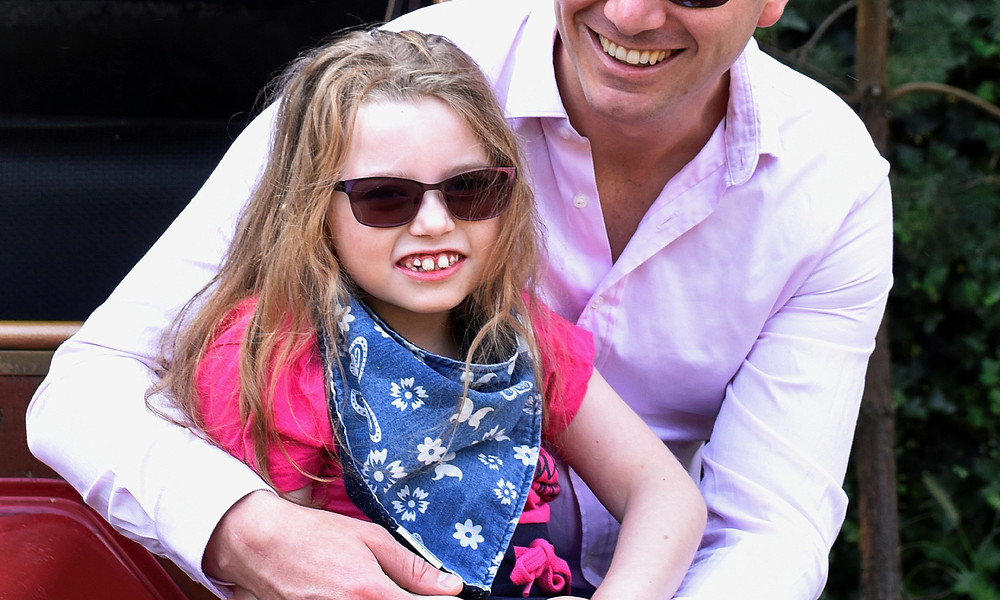More awareness about bruxism can help a large group of people
Fysiotherapie Noorderbad- Research stories


Lecturer researcher Robert Goddard conducts research into bruxism in children with Severe Multiple Disabilities (PIMD). Bruxism is a collective term for clenching and grinding of the teeth, something that happens unconsciously and that children with disabilities often have no control over. So it's not something that stops or goes away on its own. And the consequences can be very serious.
The motivation for the research was one of Robert's own daughters, a 10-year-old girl with Rett syndrome. She was in the hospital, where she received a treatment with botox, to relax the muscles in the face, which counteracts bruxism. Robert: 'I talked to the doctor about this treatment and asked him what evidence there was that it actually helps. He said there wasn't any. Experience shows that it helps, but there was no real research on this subject. I thought that was crazy. It is an invasive procedure, in which you get a syringe in your face. My daughter cannot talk. She can't give permission or say, I don't want this. You would expect that there would be evidence the treatment works.'
At Hanze, where Robert is a lecturer in physiotherapy and research & innovation, he spoke with colleague Jean Driessen. "I complained that there was no research on this subject. Then Jean said: "We're lecturer-researchers, so why not let’s do it ourselves?" So we set out a plan with a clear goal: how do we ensure that more attention is paid to evidence-based treatment of bruxism in this target group?'
A valid measuring instrument did not exist, so this had to be developed. But the researchers wanted to know first: how big is the problem and how many children suffer from it? As a caregiver and physiotherapist, Robert often visits institutions, and here he saw that almost everyone was grinding. It's a non-suppressed reflex in these people. He suspected that the problem might be even bigger than he thought and decided that he was going to do the research as part of the Master's degree in Orofacial Therapy that he is also following.
The study was designed as a Systemic Review and meta-analysis. Professor Wim Krijnen provided the statistics and Robert and Jean investigated how often bruxism occurs in children with PIMD on the basis of a prevalence study. Robert: 'It turned out to be very common among children with disabilities. In children with Down syndrome it was four out of ten, in children with Cerebral Palsy it was in five out of ten and in children with Rett syndrome it is even seven to eight out of ten.' Bruxism leads to dental damage, of course, but also potentially to pain and dental inflammation. If it happens unconsciously and you can't control it, then bruxism doesn't stop because you're in pain. The children can't stop doing it themselves.
This also means that a visit to the dentist is never easy. These children often require special dentistry. Because they can't keep their mouths open for long, they undergo anaesthesia. Robert: 'So there has to be an anaesthetist, a specialist dentist, nurses, and the treatment has to be done in the hospital. That makes the dental costs very high. Research can help reduce these costs. What will make a big difference is that doctors will become more familiar with the problem.'
Robert and Jean want to involve students in the next phase of the research. They also want to facilitate drug studies, and students can make important contributions to the research into preventive aspects. Parents play an important role in this. What do they know? Do they know the problem? Can oral hygiene at home be improved to prevent problems? Robert: 'We want to know where the problem lies. If parents already know things and are already doing things well, we don't need to give advice about that. It's about where the gaps in knowledge are. We mainly focus on what we want to improve. And there is a lot to be gained on the preventive side.'
Children can't stop doing it on their own
Towel in the ring
Robert has been doing bruxism research alongside his other work for the past three years, and it's been a huge challenge. As a part-time teacher with his own physiotherapy practice, and a family with a wife and two daughters, one of whom has severe disabilities, the pressure was sometimes very great. Robert: 'Sometimes everything came together. Then there was a deadline for an article, and my daughter was so sick that she had to go to the hospital and then it was also very busy at the Hanze. But I'm really glad we did. It was our own initiative, there was no funding. In this study, the costs were mainly in time. It often happened that I was working late at home when my wife and daughters were already in bed. I'd sit in front of the PC until three o'clock in the morning.'
His wife's support was really indispensable, says Robert. "She was very involved throughout the process and I can't stress enough how important that has been. Every now and then she would go crazy with me, but if I hadn't had her support, I would have thrown in the towel a long time ago. Jean also worked on this research for three years in his own time, in addition to his work at the Hanze. I am very grateful to him for that. And also for the support of my co-authors Aly Waninge, Wim Krijnen and doctor Vincent Roelfsema of the Martini Children's Hospital, who was also my daughter's doctor. This work has made it clear to me once again what important things are happening at the Hanze. A lot of very good research is being done here. We're punching above our weight, in that respect.'
If you can prevent something, you should
Robert researched bruxism in children, because in children some complications can still be prevented, for example by dentistry. ‘People sometimes think that orthodontics is only aesthetically pleasing, i.e. for beautiful teeth,’ says Robert. 'But for many children, it's pure necessity. The growth of your teeth determines the shape of your face. Your face can grow very differently if there are problems with the teeth. You can get facial problems, and that's something you can still prevent with small children. A lot can be adjusted surgically, but this is not possible in children with PIMD. What you can prevent, you need to do now. If teeth are in good shape, the face will also grow well. And that can prevent a lot of problems later in life.'
Surprising results
Before he started, Robert already suspected that bruxism is common in children with PIMD. But he was surprised to find how big the problem actually is. And how little research there is. Robert: 'There were very few studies that we could include in our research. I found it surprising and also disconcerting how little attention was paid to this subject. Very little is known about the problem.' This was also evident from the conversations Robert had with orofacial experts. One said: "Why do you want to investigate this? It's not that big of a deal, is it?" And an expert from Limburg saw our publication and called. He was happy with the report because he was often asked questions about bruxism and didn't have the answers. So also among specialists, awareness is lacking. This is partly due to our fragmented healthcare system, in which everyone knows everything about their own specialism, but almost nothing in another area.'
Impact: more research and prevention
Robert expects that the impact of this research will be that more attention will be paid to the subject by specialists. And as a result, dental problems can be recognized in time and perhaps even prevented, because more attention is paid to prevention. Robert: 'It would be great if more attention to this subject would also lead to more academic research. And I also hope that the pharmaceutical industry will become aware of the scale of this problem. A very large group of people would be helped if medication was given to treat bruxism in people with Multiple Severe Disabilities. And research is an important prerequisite for this.'
Would you like to know more about Robert's research?
Read his publication about bruxism hereHow satisfied are you with the information on this page?